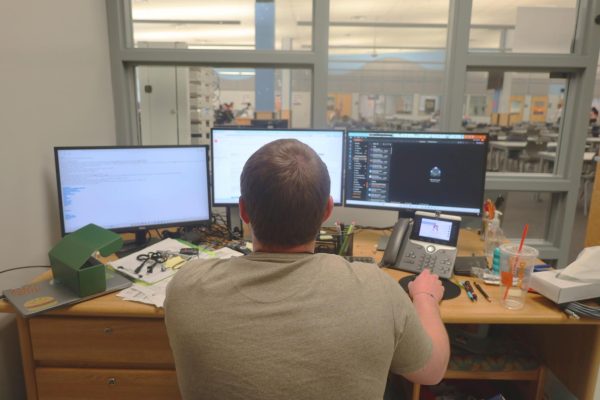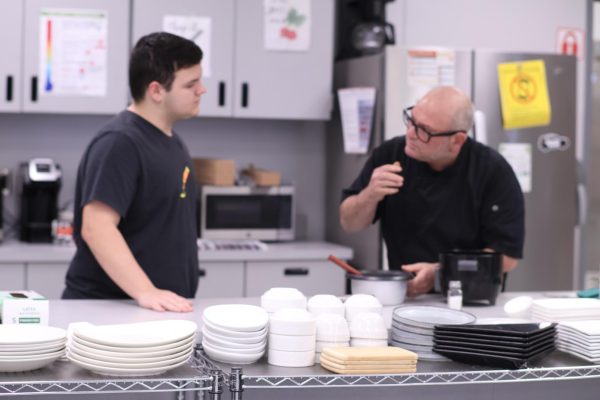Administration implements new phone procedure
photo by Nadia Knoblauch
Gretchen Knoblauch’s “parking garage” set up, where students may plug in their phones during class. Knoblauch decided to create this in order to abide with the new school policy and allow for a charging station in her class.
As sophomore Alyssa Basilo entered class, her attention was focused on a red sign on the board indicating that phones will not be allowed during the period. She was given instructions to put her phone and bag against the wall, fully out of reach for the whole period, or she will face disciplinary consequences.
This new phone procedure was set so students can identify classroom expectations immediately. In order to do this, red and green signs were distributed to every classroom. When the red side is being displayed, phones must be put away and out of reach, and when green is displayed, students are able to use their phones according to teachers’ instructions.
This school-wide procedure was made to allow smoother lessons and enhance safety around the school. Frasca believes that texting in class can lead to the discussion and planning of unsafe activities on school properties, like skipping class and leaving campus.
“A lot of our issues, like kids meeting up in bathrooms during the school day, are because they text each other in class and go to meet up,” Frasca said.
With the checkups of bathrooms and limited access to phones in class, safety is expected to improve during the school year.
It is important to understand that different classrooms may have different setups for this procedure. Calculus teacher Gretchen Knoblauch has followed it loosely, as it fits her classroom and students’ needs.
“If students do not put their phones away in their backpacks after being reminded, I have them ‘park’ their cellphones in my cell phone ‘parking garage,’” Knoblauch said.
She purchased a cell phone charging tower and various iPhone and Android charging cables for students to be able to charge their phones while it is out of their reach. Although the phone procedure has recently been set up, Knoblauch has always had her own specific phone system using her own “no phones” signs around her classroom.
“I believe it is very important that students do not become distracted by their cell phones in my class. After all, I’m not accessing my cell phone while teaching; students should not be on their phones while learning,” Knoblauch said.
Even with updated procedures, many teachers still forbid phone use in the classroom, and students continue to complain. According to a poll made on social media, out of 127 students, 79 percent disagreed with the policy.
“Either way, if kids want to be on their phones they will. The only difference is that they will be more sneaky about it,” junior Marcel Clemens said.
Frasca understood that not many parents or students were going to agree with the procedure, but still believes that it will clear up any confusion about the use of phones in the classroom.
“Students have seven classes and each does things differently [so] it becomes confusing,” Frasca said. “I thought it was really important to follow one expectation in class, so that teachers can use it however they want and manage it [on their own].”
While students generally want the freedom to use their phones, not all students are entirely against the policy.
“I somewhat agree with the policy. In my opinion, students should earn the trust to keep their phones out, but once they lose the trust then the new policy begins to really work,” Basilo said.
Your donation will support the student journalists of Hagerty High School. We are an ad-free publication, and your contribution helps us publish six issues of the BluePrint and cover our annual website hosting costs. Thank you so much!







